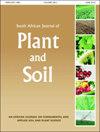Response of tomato cultivars to irrigation management strategies employed by emerging farmers in the Greater Giyani Municipality
IF 0.7
Q3 AGRONOMY
引用次数: 0
Abstract
Intensification of low-tech agricultural production is required in the Greater Giyani Municipality (Limpopo province, South Africa) to respond to changing climatic conditions, water scarcity and increased food demand of the local market. Two years of field experiments were conducted on two typical small-scale farms under real-world conditions. The objective was to test the response of locally available tomato (Lycopersicon esculentum Mill.) cultivars (Rodade, STAR 9006, Commander, HTX 14 and MFH) to two different irrigation strategies (full irrigation FI and deficit irrigation DI). While results showed high tomato yield variability (ranging between 9.2 t ha−1 and 59.7 t ha−1) depending on the farms, environmental conditions (heatwaves, diseases) and irrigation management, STAR 9006 appeared to be the best performing cultivar and HTX 14 the worst. Seasonal evapotranspiration under FI was between 400 and 620 mm depending on the length of the season and harvesting time. Crop water productivity was generally higher for DI than FI treatments. Deficit irrigation appeared to be feasible to reduce water use for some cultivars (eg cv. STAR 9006), however, an economic analysis should be conducted at specific sites/farms to determine the impacts of DI on farmers’ income as some yield losses can be expected during drought years.大吉亚尼市新兴农民采用的灌溉管理策略对番茄品种的影响
大吉亚尼市(南非林波波省)需要加强低技术农业生产,以应对不断变化的气候条件、水资源短缺和当地市场粮食需求增加。在现实条件下,在两个典型的小规模农场进行了为期两年的田间试验。目的是测试当地番茄(Lycopersicon esculentum Mill.)品种(Rodade、STAR 9006、Commander、HTX 14和MFH)对两种不同灌溉策略(完全灌溉FI和亏缺灌溉DI)的反应。结果表明,根据不同的种植方式、环境条件(热浪、病害)和灌溉管理,番茄产量变异较大(在9.2 ~ 59.7 t ha - 1之间),STAR 9006表现最好,htx14表现最差。FI下的季节蒸散量在400 ~ 620 mm之间,取决于季节长度和收获时间。DI处理的作物水分生产力普遍高于FI处理。亏缺灌溉似乎是可行的,以减少一些品种的用水量(如cv。STAR 9006),但是,应在特定地点/农场进行经济分析,以确定DI对农民收入的影响,因为在干旱年份可能会出现一些产量损失。
本文章由计算机程序翻译,如有差异,请以英文原文为准。
求助全文
约1分钟内获得全文
求助全文
来源期刊

South African Journal of Plant and Soil
Agricultural and Biological Sciences-Plant Science
CiteScore
1.90
自引率
11.10%
发文量
32
期刊介绍:
The Journal has a proud history of publishing quality papers in the fields of applied plant and soil sciences and has, since its inception, recorded a vast body of scientific information with particular reference to South Africa.
 求助内容:
求助内容: 应助结果提醒方式:
应助结果提醒方式:


